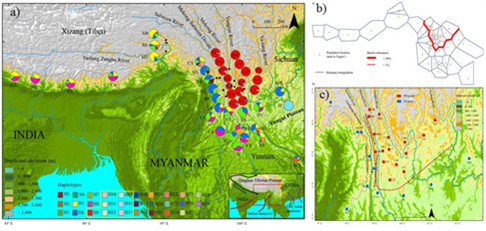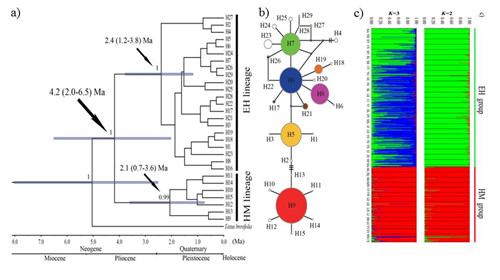The uplift of the Qinghai-Tibetan Plateau (QTP), caused by the collision of the Indian plate with the Eurasian plate, was one of the most important geological events during the Cenozoic. This event deeply affected the climate and environment of the QTP and its adjacent regions, which had a profound impact on the evolutionary dynamics of many organisms in this area. Climatic oscillations during the Pleistocene further affected the migration and dispersal of organism in the QTP. However, few is known about the response of organisms to these geological and climatological events, and the mechanisms are poorly understood hitherto due to limited detailed studies in this region, especially in the Himalaya-Hengduan Mountains region (HHM), an important biodiversity hotspot. The interplay of orographic uplift and climatic changes in the Himalaya-Hengduan Mountains region (HHM) is believed to have had a key role in speciation and population demography. However, it lacks empiric evidence for this hypothesis.
To further insight into these processes, Doc. LIU Jie, supervised by Profs. GAO Lianming and LI Dezhu, from Kunming Institute of Botany, investigated the speciation and phylogeography of Taxus wallichiana by combining molecular phylogeography and species distribution modeling. Molecular data were obtained from 43 populations of T. wallichiana. Nineteen climatic variables were analyzed alongside genetic discontinuities. Species distribution modeling was carried out to predict potential past and present distribution ranges.
Two distinct lineages were identified, which diverged c. 4.2 (2.0–6.5) million years ago (Ma), a timescale that corresponds well with the recent uplift of the Qinghai-Tibet Plateau and subsequent climatic changes of the region. Correlations with climatic variables also suggest that ecological factors may have further reinforced the separation of the two lineages. The ecological niche modeling suggested both lineages experienced population expansion during the last glaciation.
The high genetic divergence, long-term isolation and ecological differentiation suggest a scenario of cryptic speciation in T. wallichiana associated with geological and climatic changes in the HHM. Our findings also challenge the notion of general population ‘contraction’ during the last glaciation in the HHM.
This paper has been published online in New Phytologist [Liu J, Möller M, Provan J, Gao LM, Poudel RC, Li DZ. 2013. Geological and ecological factors drive cryptic speciation of yews in a biodiversity hotspot. New Phytologist: doi: 10.1111/nph.12336. http://onlinelibrary.wiley.com/doi/10.1111/nph.12336/abstract ]
This work was supported by the Key Research Program of the Chinese Academy of Sciences (KSZD-EW-Z-011); the National Natural Science Foundation of China (30700042, 31200182); the Ministry of Science and Technology of China (2012FY110800); and the talent project of Yunnan Province, China (2008YP064).

The sampling locations, haplotype distribution pattern of Taxus wallichiana and the monsoon circulations of Qinghai-Tibet Plateau (a). The geographical barrier detected by BARRIER (b, c).

The haplotype phylogeny (a, b), and microsatellite STRUCTURE analysis (c) of Taxus wallichiana.




